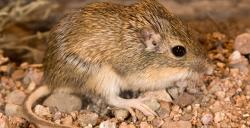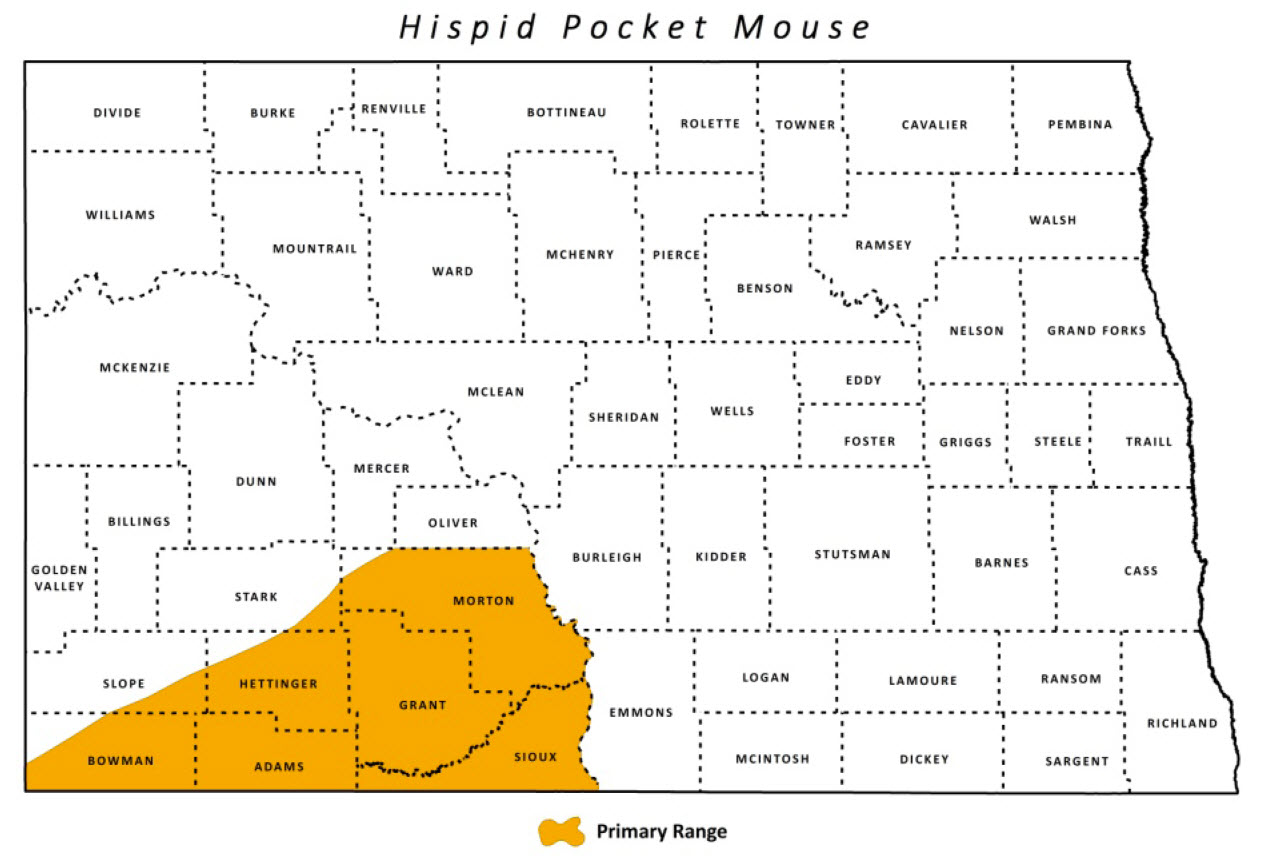
Hispid Pocket Mouse
| Scientific Name | Chaetodipus hispidus |
|---|---|
| General Description | A medium sized mouse with large back feet, whose tail is roughly the same length as its body. The fur on its back is a mix of black and tan with an orange stripe separating it from the white belly. |
| Status | Resident. |
| Abundance | Locally common. |
| Primary Habitat | Short and mixedgrass prairie tracts. Found predominantly in southern North Dakota west of the Missouri River. |
| Federal Status | No current federal status. |
| Reason for Designation | Little is known of the habits and status of this rodent. Only small pockets of this species’ habitat occur within the state, and loss of native prairie is a concern. North Dakota is considered at the northern edge of the Hispid Pocket Mouse range. |
Locations and Conditions of Key Habitat
Preferred Habitat
Hispid pocket mice prefer short and mixed-grass prairie tracts. Predominantly grainivores, they eat seeds from native grasses for food, and may also feed in grain fields.
Key Areas and Conditions for Hispid Pocket Mouse in North Dakota
No key areas have been identified for this species. Species has been documented in Morton, Grant, Sioux, Hettinger, Adams, Bowman, and Slope Counties.
Problems Which May Affect this Species
Habitat
Conversion of native and tame grass tracts from grazing and hay land to crop land is the greatest threat for this rodent. This action reduces food sources and removes critical cover for nesting and protection.
Other Natural or Manmade Factors
Disease may be factor for this species.
Research and Survey Efforts
Current Research or Surveys
- Northeastern State University and Dickinson State University are currently studying “Fringe Mammals” in western North Dakota. This includes Hispid Pocket Mouse.
Previous Research or Surveys
- A number of agencies have surveyed for small mammals in the southwestern part of the state, including REAP, Theodore Roosevelt National Park, the U.S. Forest Service, and U.S. Bureau of Land Management.
- Northern Prairie Wildlife Research Center has of developed an annotated bibliography for mammals in North Dakota.
- The University of North Dakota conducted small mammal and herptile surveys in Southwestern North Dakota in 2006.
- Dickinson State University surveyed small mammals in western North Dakota as part of a Black-tailed Prairie Dog survey.
Additional Research or Surveys Needed
- All aspects of this species ecology need to be examined, including abundance, reproduction, habitat requirements, and threats.
- Develop a monitoring protocol for small mammals in North Dakota.
Management Recommendations
- Protect native prairie where possible.
- Work with city planners to conserve existing native prairie.
- Consider removal of dilapidated shelterbelts or stands of trees within grassland, particularly within 50 meters of grassland patches greater than 100 ha.
- Implement grazing systems to benefit grassland species.
- Work cooperatively with state and federal agencies to develop BMP’s that promote use of fire.
- Control noxious weeds through biological and chemical methods.
- Use fire or other tools to prevent woody invasion of grassland.
- Work with state and federal agencies to enforce existing pesticide regulations.
- Coordinate with wind energy companies to minimize impacts.
- Survey areas of data gaps. Continue to conduct research/surveys to establish baseline information on Hispid Pocket Mouse.
Monitoring Plans
No monitoring plan has yet been developed.
2005-2015 Progress
The Hispid Pocket Mouse maintains a Level III on the Species of Conservation Priority list. A better understanding of this species historic distribution has been developed, but information on life history is still lacking. A Fringe Mammal Surveys (SWG T-39-R ) will gather data on the Hispid Pocket Mouse.

Note: A listing of works consulted when compiling the information on this page may be found in the 2015 State Wildlife Action Plan.
